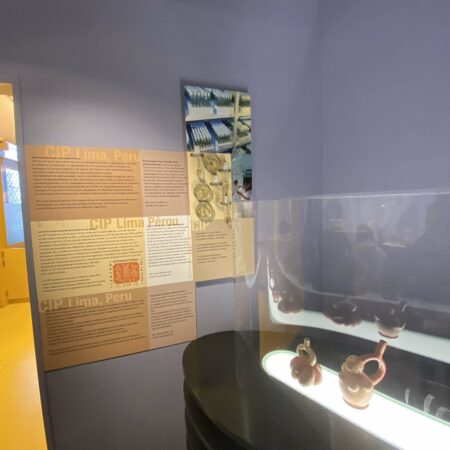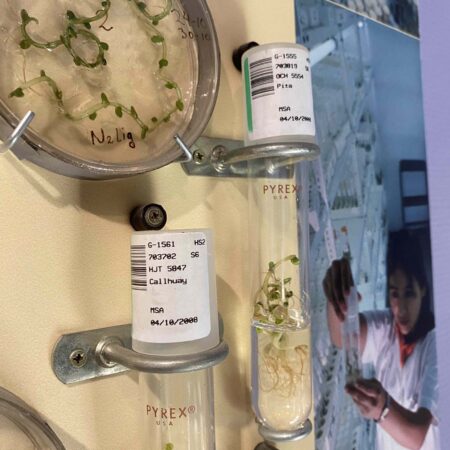- The expansion of agriculture has shaped the recent evolutionary history of a specialized squash pollinator. The genetic diversity of an insect crop pollinator has been affected by the fact that it pollinates a crop.
- Native pollinators improve the quality and market value of common bean. The diversity of native insect crop pollinators affects the value of the crop they pollinate.
- A global approach for natural history museum collections. Basically amounts to “ask curators what they have.” Including presumably specimens of insect pollinators. We’ve been doing this for PGRFA for quite a while now, one way or another. Back to mainly plants next week, hopefully, but let’s keep going with animals for now, and let’s see what more we can learn.
- A 12% switch from monogastric to ruminant livestock production can reduce emissions and boost crop production for 525 million people. Ruminants are not all bad after all.
- Permafrost preservation reveals proteomic evidence for yak milk consumption in the 13th century. The Mongols thought this particular ruminant was just great.
- The self-management organization as a way for the in situ conservation of native poultry genetic resources. In response to the promotion of exotic commercial poultry breeds, women’s groups in Mexico have got together and developed rules to protect native hens. Please let not these be among the 12% of monogastrics that get replaced by yaks.
- Increasing the number of stressors reduces soil ecosystem services worldwide. It’s the number of different stressors, more than their aggregate strength, that most affects how badly soils are stressed. Goes for me too, to be honest.
- Elephants as an animal model for self-domestication. I’ll believe it when elephants domesticate yaks.
Showcasing potato diversity
Great to see the International Potato Centre (CIP)…
…and its genebank…
…highlighted in the Frietmuseum in Bruges.
And yes, those accessions are in Genesys.
Genebanks as force multipliers
The Center on Global Food and Agriculture has a report out called “Defining the Path to Zero Hunger in an Equitable World” which basically tries to add humanitarian assistance to the old food-climate-biodiversity nexus. Crop diversity is nowhere to be found among the “catalyzing ideas,” alas. However, one of those ideas is investing in “force multipliers,” and one of those multipliers is agricultural research and development. So I guess there’s an opening there for genebanks. But why do they have to be such a hard sell?
Ah but wait, I see other catalyzing ideas are “get the word out” and “articulate what we want.” Roger that.
Brainfood: 100 plant science questions, Biodiversity data, Cropland expansion double, CC & yields, Crop diversity & stability, Nutritious crops double, Feminist markets
- One hundred important questions facing plant science: an international perspective. How do we leverage existing genetic diversity to create climate-resilient crops? is only number 3 you say? I’ll take it. And in fact that broad question gets deconstructed in questions 36-71. Now, let’s see how today’s haul of papers relates to that, shall we?
- A strategy for the next decade to address data deficiency in neglected biodiversity. Well, yeah, easy one, clearly you need data to conserve the crop wild relatives that could help you breed those climate-resilient crops.
- Post-2020 biodiversity framework challenged by cropland expansion in protected areas. Apart from anything else, that data would tell you which CWR in protected areas are threatened with cropland expansion, and said CWR could help you with breeding crops that could limit cropland expansion by increasing production on existing cropland. Could, could, could…
- Global Maps of Agricultural Expansion Potential at a 300 m Resolution. That cropland expansion might do less damage in some places than others. Still with me?
- Increased probability of hot and dry weather extremes during the growing season threatens global crop yields. Right, that’s why those CWR might come in useful. Assuming you can still find them with all that cropland expansion.
- Divergent impacts of crop diversity on caloric and economic yield stability. At the state level within the USA, crop species diversity is positively associated with yield stability when yield is measured in $ but negatively when measured in calories. Now do it for genetic diversity.
- Role of staple cereals in human nutrition: Separating the wheat from the chaff in the infodemics age. The benefits of those climate-resilient, more nutritious crops need to be better communicated.
- Simple solutions for complex problems? What is missing in agriculture for nutrition interventions. What does nutritious mean anyway?
- “Whose demand?” The co-construction of markets, demand and gender in development-oriented crop breeding. Who is it that wants those climate-resilient, nutritious crops anyway?
- Take-home message: leveraging existing genetic diversity to create climate-resilient crops might be the easy part.
How Native Americans got their horses
You know how you read in history textbooks that the Native Americans of the Great Plains got hold of horses from retreating Spanish colonists after the Pueblo Revolt of 1680? And you know how Native Americans have been saying that’s not what they think happened? That they in fact got their horses long before that? You know how rare it is that a scientific paper involving museum specimens and DNA includes Indigenous authors? And that said paper overturns a mainstream historical narrative and is then splashed all over the mainstream media? Very rare, that’s how rare.

